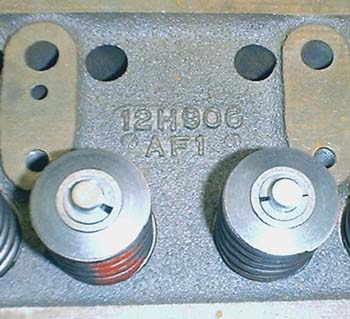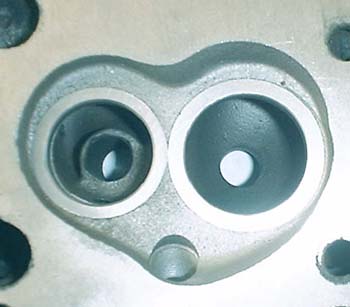Identifying MGB Cylinder Heads Throughout it's manufacture, variations of the original MGB cylinder head design were produced. The following information relates mainly to North American spec cars and should not be considered whole or complete, but is true and correct to the best of our knowledge. Anyone possessing greater knowledge is invited to e-mail us for additions or corrections. We'd like to make this page a "landmark" for MGB enthusiasts the world over. Early heads, 12H-906: The earliest heads used (model year 1964-1965) on MGB's were casting number 12H-906. They were equipped with 1.5625" inlet valves and 1.343" exhausts. The rocker pedestal oil feed hole is in-line with the bolt holes. The combustion chamber type is "closed" with a depth of roughly .400" and a volume of around 42cc's. These heads did not require exhaust valve cut-outs in the block and provided 8.8:1 compression with the shallow dish pistons used in earlier engines. These heads were fitted with "Type A" valves, spring hardware and dual springs.
12H-1326: The next heads used (model years 1965-1968) were casting number 12H-1326, which provided an improvement in casting quality. These heads have 1.5625" inlet valves and 1.343" exhausts and the rocker pedestal oil feed hole is in-line with the bolt holes. The combustion chamber type is "closed" with a depth of roughly .400" and a volume of around 42cc's. These heads do not require exhaust valve cut-outs in the block and provide 8.8:1 compression with the shallow dish pistons used in earlier engines. These heads were fitted with "Type A" valves, spring hardware and dual springs.
12H-2389: For model years 1969-1971, casting number 12H-2389 was used, this being the first of the "smog heads". The biggest change over from the previous heads being addition of the air injector holes destined to adorn all further renditions to come. These heads were still equipped with 1.5625" inlet valves and 1.343" exhausts. The rocker pedestal oil feed hole is in-line with the bolt holes. The combustion chamber type is "closed" with a depth of roughly .400" and a volume of around 42cc's. These heads do not require exhaust valve cut-outs in the block and provide 8.8:1 compression with the shallow dish pistons used in earlier engines. These heads were fitted with "Type B" valves, spring hardware and dual springs.
12H-2923: Starting in 1972 and lasting until about 1974 and a half, casting number 12H-2923 was used, this being the only production "big valve" head. We have also seen this same head with casting number 12H-2709 or 12H-2708 in European guise (without the air injector ports). These heads had two major changes from the 2389, one being the new 1.625" inlet valves and the other being a newly revised "open style" combustion chamber. These heads were still equipped with 1.343" exhaust valves. The rocker pedestal oil feed hole is in-line with the bolt holes. The combustion chamber depth is roughly .375" and has a volume of around 38cc's. These heads do require exhaust valve cut-outs in the block and provide 8.0:1 compression with the deeper dished pistons used in the new, later style engines. Because of the larger valve sizes and shallower chamber, these heads are commonly sought after items for racing and high performance use. These heads were fitted with "Type B" valves and spring hardware, but only used single valve springs.
CAM-1106: Just as the 2923 heads were being phased out (about 1974), casting number CAM-1106 became the standard North American issue up through the close of production. These heads have some distinct differences over their predecessors. While still equipped with 1.343" exhaust valves they were only fitted with the now smaller 1.5625" inlets. The rocker pedestal oil feed hole location was changed to be offset with the bolt holes and a new water choke outlet port was located at the back of the head to supply the water heated choke of the Zenith Stromberg carburetor. The combustion chamber depth is roughly .375" and has a volume of around 38cc's. These heads do require exhaust valve cut-outs in the block and provide 8.0:1 compression with the deeper dished pistons used in the new, later style engines. Because of their "smog car" association, these heads are not commonly sought after for performance use, but can work just as well as earlier models once modified. These heads were fitted with "Type B" valves, spring hardware and single springs. Some (but not all) of these heads were induction hardened to better cope with newer unleaded fuels, however this possibility should not be relyed upon.
12H-4743: We've found the 12H-4743 heads to be perfect copies of the CAM-1106 heads. Our knowledge does not extend far beyond that statement at this time. 12H-4736: These heads are essentially a CAM-1106 casting but with minor differences. We believe these heads may have come originally on Austin cars (such as the Marina or 1800-S) or were some type of factory replacement part. The outer shaping of the head was revised and gives a smoother appearance with the removal of the patent number from the front of the head near the thermostat housing. These heads are usually found with the air injection holes drilled, but may or may not be found with the water choke outlet hole drilled. The oil feed hole to the rockers has been offset in all the examples of these heads we've come across. These heads were equipped with 1.343" exhaust valves and 1.5625" inlets. The combustion chamber depth is roughly .375" and has a volume of around 38cc's. These heads do require exhaust valve cut-outs in the block and provide 8.0:1 compression with the deeper dished pistons used in the later style engines. Because of their "smog car" association, these heads are not commonly sought after for performance use, but can work just as well as earlier models once modified. These heads were fitted with "Type B" valves, spring hardware and unknown spring packages (dual springs in most cases we've seen)
Other Items Of Interest:
Note should be made that some Indian-cast, aftermarket copies of these heads exist. Our finding is these heads have questionable core positioning and may not be suitable for use in performance applications. These heads can be identified by the casting marks and we'll get some photos up when possible. Home | Cylinder Heads | Articles ©2008 Sean Brown All rights reserved. |




















